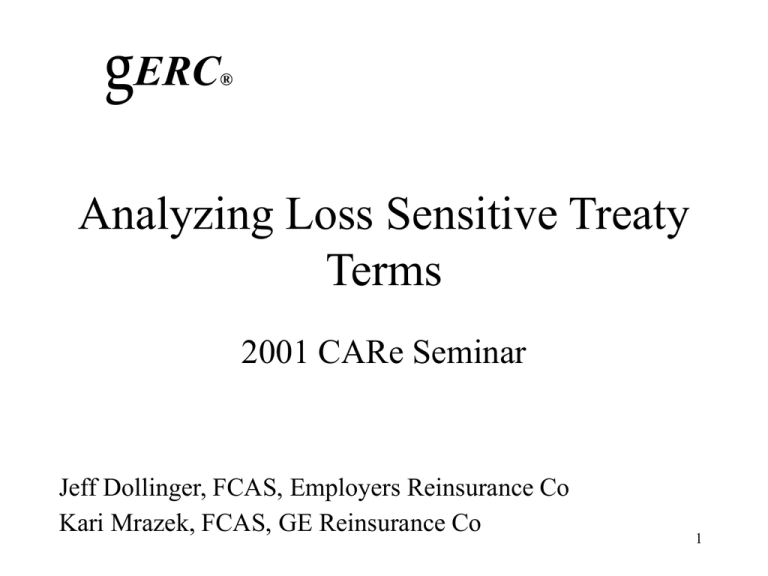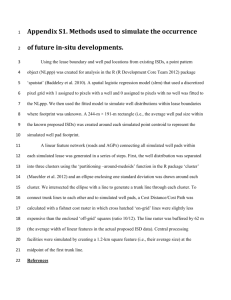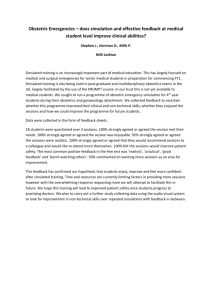Pricing Example 5
advertisement

gERC
®
Analyzing Loss Sensitive Treaty
Terms
2001 CARe Seminar
Jeff Dollinger, FCAS, Employers Reinsurance Co
Kari Mrazek, FCAS, GE Reinsurance Co
1
Introduction to Loss Sharing
Provision
• Definition: A reinsurance contract provision that varies the
ceded premium, loss, or commission based upon the loss
experience of the contract
• Purpose: Client shares in ceded experience & could be
incented to care more about the reinsurer’s results
• Typical Loss Sharing Provisions
g
–
–
–
–
–
–
Profit Commission
Sliding Scale Commission
Loss Ratio Corridors
Annual Aggregate Deductibles
Swing Rated Premiums
Reinstatements
2
Simple Profit Commission
Example
• A property prorata contract has the following
profit commission terms
– 50% Profit Commission after a reinsurer’s margin of 10%.
– Key Point: Reinsurer returns 50% of the contractually
defined “profit” to the cedant
– Profit Commission Paid to Cedant =
50% x (Premium - Loss - Commission - Reinsurers
Margin)
– If profit is negative, reinsurers do not get any additional
money from the cedant.
g
3
Simple Profit Commission
Example
• Ceding Commission = 30%
• Loss ratio must be less than 60% for us to pay a profit
commission
• Contract Expected Loss Ratio = 70%
• $1 Prem - $0.7 Loss - $0.3 Comm - $0.10 Reins Margin =
minus $0.10
• Is the expected cost of profit commission zero?
g
4
Simple Profit Commission
Example
• Answer: The expected cost of profit commission is
not zero
• Why: Because 70% is the expected loss ratio.
– There is a probability distribution of potential outcomes
around that 70% expected loss ratio.
– It is possible (and may even be likely) that the loss ratio
in any year could be less than 60%.
g
5
Cost of Profit Commission:
Simple Quantification
• Earthquake exposed California property prorata treaty
• LR = 40% in all years with no EQ
• Profit Comm when there is no EQ = 50% x ($1 of Premium $0.4 Loss - $0.30 Commission - $0.1 Reinsurers Margin)
= 10% of premium
• Cat Loss Ratio = 30%.
– 10% chance of an EQ costing 300% of premium, 90% chance no
EQ loss
g
Cost of Profit Comm =
Profit Comm Costs 10% of Prem x 90% Probability of No EQ
+ 0% Cost of PC x 10% Probability of EQ Occurring = 9% of Prem
6
Basic Mechanics of Analyzing
Loss Sharing Provisions
• Build aggregate loss distribution
• Apply loss sharing terms to each point on
the loss distribution or to each simulated
year
• Calculate a probability weighted average
cost (or saving) of the loss sharing
arrangement
g
7
Example of Basic Mechanics: PC: 50% after
10%, 30% Commission, 65% Expected LR
Cost of PC
Loss Ratio Band
at avg LR
Low
High
Avg in Band Probability in Band
20%
30%
25%
2.8%
17.5%
30%
40%
35%
9.4%
12.5%
40%
50%
45%
15.2%
7.5%
50%
60%
55%
20.9%
2.5%
60%
70%
65%
17.4%
0.0%
70%
80%
75%
15.1%
0.0%
80%
90%
85%
10.1%
0.0%
90%
100%
95%
5.8%
0.0%
100% 150%
125%
1.4%
0.0%
150% 200%
175%
1.1%
0.0%
200% 300%
250%
0.5%
0.0%
300% 400%
350%
0.3%
0.0%
Average:
65.0%
100.0%
3.3%
g
CR
at avg LR
in Band
72.5%
77.5%
82.5%
87.5%
95.0%
105.0%
115.0%
125.0%
155.0%
205.0%
280.0%
380.0%
98.3%
Cost of Profit Comm & CR at expected LR doesn't equal
expected Cost of Profit Comm and expected CR
8
Determining an Aggregate
Distribution - 2 Methods
• Fit statistical distribution to on level loss ratios
– Reasonable for prorata treaties.
• Determine an aggregate distribution by modeling
frequency and severity
– Typically used for excess of loss treaties.
g
9
Fitting a Distribution to On Level
Loss Ratios
• Most actuaries use the lognormal distribution
– Reflects skewed distribution of loss ratios
– Easy to use
• Lognormal distribution assumes that the
natural logs of the loss ratios are distributed
normally.
g
10
Incremental Probability
Skewness of Lognormal
Distribution
25.00%
20.00%
15.00%
10.00%
5.00%
0.00%
110-120%
100-110%
90-100%
80-90%
70-80%
60-70%
50-60%
40-50%
30-40%
20-30%
10-20%
0-10%
Loss Ratios
g
11
Fitting a Lognormal Distribution
to Projected Loss Ratios
g
• Fitting the lognormal
s^2 = LN(CV^2 + 1) m = LN(mean) - s^2/2
Mean = Selected Expected Loss Ratio
CV = Standard Deviation over the Mean of the
loss ratio (LR) distribution.
• Prob (LR X) = Normal Dist(( LN(x) - m )/ s)
i.e.. look up (LN(x) - m )/ s) on a standard
normal distribution table
12
Fitting a Lognormal Loss Ratio
Distribution
• Producing a distribution of loss ratios
– For a given point i on the CDF, the following Excel
command will produce a loss ratio at that CDFi:
Exp (m + Normsinv(CDFi) x s)
• Key Question: Is the resulting LR distribution
reasonable
– Analyze that issue by reviewing historical data
– Discuss this issue with your underwriter
– If the distribution is not reasonable, adjust the CV selection.
g
13
Sample Lognormal Loss Ratio
Distribution
On Level
Year
LR
1993
65.5%
1994
70.0%
1995
55.0%
1996
48.0%
1997
72.0%
1998
65.0%
1999
55.0%
Mean LR:
61.5%
standard deviation:
8.92%
Calculated CV:
0.15
Selected CV:
0.17
Lognormal Mu:
(0.500)
Lognormal Sigma:
0.169
g
CDF
10.0%
20.0%
30.0%
40.0%
50.0%
60.0%
70.0%
80.0%
90.0%
95.0%
98.0%
99.0%
Modeled
LR
48.8%
52.6%
55.5%
58.1%
60.6%
63.3%
66.2%
69.9%
75.3%
80.0%
85.8%
89.8%
14
Additional Considerations for Fitting
a Lognormal Loss Ratio Distribution
• Selected CV should usually be above indicated
– 5 to 10 years of data does not reflect full range of
possibilities
• Parameter Uncertainty: Do you really know the
true mean of the loss ratio distribution for the
upcoming year?
g
15
Modeling Parameter Uncertainty:
One Possible Method
• Select 3 equally likely expected loss ratios
• Assign weight to each loss ratio so that the weighted
average ties to your selected expected loss ratio
– Example: Expected LR is 65%, assume 1/3 probability
that true mean LR is 60%, 1/3 probability that it is 65%,
and 1/3 probability that it is 70%.
– Simulate the “true” expected loss ratio
g
• Simulate the loss ratio for the year modeled using the
lognormal based on simulated expected loss ratio &
your selected CV
16
Example of Modeling Parameter
Uncertainty
1) Simulate Expected Loss Ratio
Simulated random variable from 0 to 0.33: Choose 60%
Simulated random variable from 0.33 to 0.67: Choose 65%
Simulated random variable from 0.67 to 1,00: Choose 70%
Simulated Random Variable:
0.8
Simulated Expected Loss Ratio:
70.0%
2) Calculate New Lognormal Parameters
Sigma (same as original selection):
Simulated Lognormal Mu:
Mu = LN(Expected LR) - Sigma^2/2
g
0.17
(0.37)
3) Simulate Loss Ratio for Year Based on New Lognormal Mu
Simulated Random Variable (CDFi):
0.842
# of St. Deviations Away from Mean [Normsinv(CDFi)]: 1.00
Simulated Loss Ratio:
81.7%
Exp (mu + Normsinv(CDFi) x sigma)
17
Common Loss Sharing
Provisions for Prorata Treaties
• Profit Commissions
– Already covered
• Sliding Scale Commission
• Loss Ratio Corridor
• Loss Ratio Cap
g
18
Sliding Scale Comm
• Commission initially set at Provisional
amount
• Ceding commission increases if loss ratios
are lower than expected
• Ceding commission decreases if losses are
higher than expected
g
19
Sliding Scale Commission
Example
• Provisional Commission: 30%
• If the loss ratio is less than 65%, then the commission
increases by 1 point for each point decrease in loss ratio up
to a maximum commission of 35% at a 60% loss ratio
• If the loss ratio is greater than 65%, the commission
decreases by 0.5 for each 1 point increase in LR down to a
minimum comm of 25% at a 75% loss ratio
g
20
Sliding Scale Commission Solution
Loss Ratio Band
Low
High
Lognormal Parameters
0.0%
52.5%
45.0%
11.91%
35.0%
80.0%
Mean LR:
65.0%
52.5%
57.5%
57.5%
62.5%
55.0%
60.0%
14.18%
18.08%
35.0%
35.0%
90.0%
95.0%
Selected CV:
Lognormal Mu:
17.0%
(0.45)
62.5%
67.5%
65.0%
17.98%
30.0%
95.0%
Lognormal Sigma:
67.5%
72.5%
77.5%
87.5%
100.0%
200.0%
72.5%
77.5%
87.5%
100.0%
200.0%
300.0%
70.0%
75.0%
82.5%
93.8%
135.0%
228.0%
14.67%
10.22%
9.73%
2.82%
0.42%
0.00%
27.5%
25.0%
25.0%
25.0%
25.0%
25.0%
97.5%
100.0%
107.5%
118.8%
160.0%
253.0%
30.7%
95.5%
Prob Wtd Avg
g
Avg LR
in Band
Ceding
Comm @
avg LR in CR @ avg
Band
LR in Band
Probability
64.9%
Max Comm
Prov Comm
Min Comm
0.17
LR
Comm
60%
35%
65%
30%
75%
25%
Conclusion: Expected cost of commission is not 30%.
21
Loss Ratio Corridors
• A loss ratio corridor is a provision that forces the ceding
company to retain losses that would be otherwise ceded
to the reinsurance treaty
• Loss ratio corridor of 100% of the losses between a 75%
and 85% LR
– If gross LR equals 75%, then ceded LR is 75%
– If gross LR equals 80%, then ceded LR is 75%
– If gross LR equals 85%, then ceded LR is 75%
– If gross LR equals 100%, then ceded LR is ???
g
22
Loss Ratio Cap
• This is the maximum loss ratio that could be ceded
to the treaty.
• Example: 200% Loss Ratio Cap
– If LR before cap is 150%, then ceded LR is
150%
– If LR before cap is 250%, then ceded LR is
200%
g
23
Loss Ratio Corridor Example
• Reinsurance treaty has a
loss ratio corridor of
50% of the losses
between a loss ratio of
70% and 80%.
• Use the aggregate
distribution to your right
to estimate the ceded LR
net of the corridor
g
Loss Ratio Band
Low
High
0.0%
50.0%
50.0%
60.0%
60.0%
65.0%
65.0%
70.0%
70.0%
75.0%
75.0%
80.0%
80.0%
85.0%
85.0% 100.0%
100.0% 200.0%
200.0% 300.0%
Avg LR
in Band
45.0%
55.0%
62.5%
67.5%
72.5%
77.5%
82.5%
92.5%
135.0%
228.0%
Probability
14.23%
33.82%
17.47%
13.71%
9.28%
5.58%
3.05%
2.61%
0.25%
0.00%
24
Loss Ratio Corridor Example Solution
Loss Ratio Corridor
50.0% between 70.0%
&
80.0%
Loss Ratio Band
Low
g
High
0.0%
52.5%
52.5%
57.5%
57.5%
62.5%
62.5%
67.5%
67.5%
72.5%
72.5%
77.5%
77.5%
82.5%
82.5%
100.0%
100.0%
200.0%
200.0%
300.0%
Prob Wtd Avg:
Avg LR
in Band Probability
48.0%
11.91%
55.0%
14.18%
60.0%
18.08%
65.0%
17.98%
70.0%
14.67%
75.0%
10.22%
80.0%
9.73%
92.5%
2.82%
135.0%
0.42%
228.0%
0.00%
64.9%
Savings
from
Corridor
0.0%
0.0%
0.0%
0.0%
0.0%
2.5%
5.0%
5.0%
5.0%
5.0%
0.9%
LR Net
of
Corridor
48.0%
55.0%
60.0%
65.0%
70.0%
72.5%
75.0%
87.5%
130.0%
223.0%
64.0%
25
Modeling Property Treaties with
Significant Cat Exposure
• Model noncat & cat LR’s separately
– Non Cat LR’s fit to a lognormal curve
– Cat LR distribution produced by commercial
catastrophe model
• Combine (convolute) the noncat & cat loss ratio
distributions
g
26
Convoluting Noncat & Cat LR’s
- Example
Non cat
LR
Prob
40%
10%
55%
25%
65%
35%
77%
25%
100%
5%
These probabilities
correspond to
these total LR's
g
Disretized Cat LR's
0%
30% 60%
60%
20% 15%
6.0%
2.0% 1.5%
15.0%
5.0% 3.8%
21.0%
7.0% 5.3%
15.0%
5.0% 3.8%
3.0%
1.0% 0.8%
100%
5%
0.5%
1.3%
1.8%
1.3%
0.3%
Total Loss Ratios
40%
70% 100%
55%
85% 115%
65%
95% 125%
77%
107% 137%
100%
130% 160%
140%
155%
165%
177%
200%
27
Truncated Loss Ratio
Distributions
• Problem: To reasonably model the possibility of
high LR requires a high lognormal CV
• High lognormal CV often leads to unrealistically
high probabilities of low LR’s, which overstates
cost of PC
• Solution: Don’t allow LR to go below selected
minimum, e.g.. 0% probability of LR<30%
g
– Adjust lognormal mean so that aggregate distribution
will probability weight back to initial expected LR
28
Summary of Loss Ratio
Distribution Method
• Advantage:
– Easier and quicker than separately modeling frequency and
severity
– Reasonable for most prorata treaties
• Usually inappropriate for excess of loss contracts
g
– Continuous distribution around the mean does not reflect the
hit or miss nature of many excess of loss contracts
– Understates probability of zero loss
– Understates potential of losses much greater than the
expected loss
29
Excess of Loss Contracts: Separate
Modeling of Frequency and Severity
• Used mainly for modeling excess of loss contracts
• A detailed mathematical explanation is beyond the scope
of this session
• Software that can be Used to do the above modeling
–
–
–
–
g
Crystal Ball
Crimcalc
@Risk
Excel
• Most aggregate distribution approaches assume that
frequency and severity are independent
30
Common Frequency
Distributions
• Poisson
f(x|l) = exp(-l) l^x / x!
where l = mean of the claim count distribution
and
x = claim count = 0,1,2,...
g
31
Fitting a Poisson Claim Count
Distribution
• Estimate ultimate claim counts by year
• Multiply ultimate claim counts by frequency trend factor to
bring them to the frequency level of the upcoming treaty
year
• Adjust for change in exposure levels, ie.
Adjusted Claim Count year i =
Trended Ultimate Claim Count i x
(SPI for upcoming treaty year / On Level SPI year i)
• Poisson parameter l equals the mean of the ultimate,
trended, adjusted claim counts from above
g
32
Example of Simulated Claim
Count
Year
1991
1992
1993
1994
1995
1996
1997
1998
1999
2000
2001
SPI at Reported Count Est Ult Annual
Freq
2001 Rate Claim
Devel Claim Freq Trend to
Level
Count Factor Count Trend
2001
10,000
2.0
1.0
2.0
0.0%
1.104
10,500
1.0
1.0
1.0
0.0%
1.104
11,025
1.0
1.0
1.0
0.0%
1.104
11,576
1.0
1.1
1.1
0.0%
1.104
12,155
3.0
1.1
3.3
0.0%
1.104
12,763
1.2
0.0%
1.104
13,401
1.3
2.0%
1.082
14,071
1.5
2.0%
1.061
14,775
1.0
2.0
2.0
2.0%
1.040
15,513
1.0
3.5
3.5
2.0%
1.020
16,000
2.0%
Note: Exposure Adj Factor Yr i = 2001 SPI / SPI year i
g
Trended Exposure Level
Claim
Adj
Claim
Count
Factor Count
2.21
1.60
3.53
1.10
1.52
1.68
1.10
1.45
1.60
1.16
1.38
1.60
3.64
1.32
4.80
1.25
1.19
1.14
2.08
1.08
2.25
3.57
1.03
3.68
Average:
Variance:
Selected Variance:
1.92
2.82
3.11
33
Modeling Frequency- Negative
Binomial
• Negative Binomial: Same form as the poisson distribution,
except that it assumes that l is not fixed, but rather has a
gamma distribution around the selected l
– Claim count distribution is negative binomial if the variance
of the count distribution is greater than the mean
– The gamma distribution around l has a mean of 1
• Negative Binomial is the preferred distribution
g
– Reflects parameter uncertainty regarding the true mean
claim count
– The extra variability of the Negative Binomial is more in
line with historical experience
34
Algorithm for Simulating Claim
Counts
• Poisson
– Manually create a poisson cumulative distribution
table
– Simulate the CDF (a number between 0 and 1) and
lookup the number of claims corresponding to that
CDF. This is your simulated claim count for year 1
– Repeat the above two steps for however many
years that you want to simulate
g
35
Additional Steps for Simulating Claim
Counts using Negative Binomial
• Determine contagion parameter, c, of claim count
distribution:
(s^2 / m) = 1 + c m
If the claim count distribution is poison, then c=0
If it is negative binomial, then c>0
• Solve for the contagion parameter:
c = [(s^2 / m) - 1] / m
g
36
Additional Steps for Simulating Claim
Counts using Negative Binomial
• Simulate gamma random variable with a mean of 1
– Gamma distribution has two parameters: a and b
a = 1/c; b = c
– Using Excel, simulate gamma random variable as follows
Gammainv(Simulated CDF, a, b)
– Simulated Poisson parameter =
=l x Simulated Gamma Random Variable Above
– Use the poisson distribution algorithm using the above simulated
poisson parameter, l, to simulate the claim count for the year
g
37
Year 1 Simulated Negative
Binomial Claim Count
(A)
(B)
(C)
(D)
(E)
(F)
(G)
(H)
Selected Mean Claim Count/Poisson Gamma
Selected Variance of Claim Count Distribution
Contagion Parameter [(Variance / Mean -1) / Mean]
Gamma Distribution Alpha
Gamma Distribution Beta
Simulated Gamma CDF
Simulated Gamma Random Variable
Simulated Poisson Parameter (A) X (G)
Simulated Poisson Parameter
Simulated Poisson CDF:
Year 1 Simulated Claim Count:
g
1.92
3.11
0.32
3.08
0.32
0.412
0.78
1.50
1.50
0.808
2
38
Year 1 Simulated Negative
Binomial Claim Count
Simulated Poisson Gamma
Simulated Poisson CDF:
Year 1 Simulated Claim Count:
Prob
Claim Poisson
Count ClaimPoisson
Count Probability <= X CountProbability
0
22.39% 22.39% 5
1.40%
1
33.51% 55.90% 6
0.35%
2
25.07% 80.97% 7
0.07%
3
12.51% 93.48% 8
0.01%
4
4.68% 98.16% 9
0.00%
g
1.50
0.808
2
Prob
Count
<= X
99.56%
99.91%
99.98%
100.00%
100.00%
39
Year 2 Simulated Negative
Binomial Claim Count
Selected Mean Claim Count/Poisson Gamma
Simulated Gamma CDF
Simulated Gamma Random Variable
Simulated Poisson Gamma (A) X (G)
g
1.92
0.668
1.15
2.20
40
Year 2 Simulated Negative
Binomial Claim Count
Simulated Poisson Gamma
Simulated Poisson CDF:
Year 2 Simulated Claim Count:
2.20
0.645
3
Prob
Prob
Claim Poisson
Count Claim Poisson
Count
Count Probability <= X Count Probability <= X
0
11.13% 11.13%
5
4.73%
97.53%
1
24.44% 35.57%
6
1.73%
99.26%
2
26.83% 62.40%
7
0.54%
99.80%
3
19.63% 82.03%
8
0.15%
99.95%
4
10.77% 92.80%
9
0.04%
99.99%
g
41
Modeling Severity
• Common Severity Distributions
–
–
–
–
Lognormal
Pareto
Mixed Exponential (currently used by ISO)
Truncated Pareto. This curve was used by ISO before moving to
the Mixed Exponential and will be the focus of this presentation.
Key Point: The ISO Truncated Pareto focused on modeling
the larger claims. Typically those over $50,000
g
42
Truncated Pareto
• Truncated Pareto Parameters
t = truncation point.
s = average claim size of losses below truncation point
p = probability claims are smaller than truncation point
b = pareto scale parameter
q = pareto shape parameter
• Cumulative Distribution Function
F(x) = 1 - (1-p) ((t+ b)/(x+ b))^q
Where x>t
g
43
Algorithm for Simulating
Severity to the Layer
• For each loss to be simulated, choose a random number
between 0 and 1. This is the simulated CDF
• Transformed CDF for losses hitting layer (TCDF) =
Prob(Loss<Reins Att Pt) +
Simulated CDF x (1 - Prob(Loss<Reins Att Pt))
• Find simulated ground up loss, x, that corresponds to
simulated TCDF
Doing some algebra, find x using the following formula:
x = Exp{ln(t+b) - [ln(1-TCDF) - ln(1-p)]/Q} - b
g
• From simulated ground up loss calculate loss to the layer
44
Year 1 Loss # 1 Simulated
Severity to the Layer
Pareto Parameters
B
79,206
Q
1.39
P
0.858
Reinsurance Layer:
750,000
Pareto Probability of Loss < Reins Att Point:
Simulated CDF:
Transformed CDF for Losses Simulated to the Excess Layer:
Simulated Loss:
Simulated Loss to Layer:
g
S
6,090
T
50,000
xs
250,000
96.13%
0.4029
0.9769
397,876
147,876
45
Year 1 Loss # 2 Simulated
Severity to the Layer
Pareto Parameters
B
79,206
Q
1.39
P
0.858
Reinsurance Layer:
750,000
Pareto Probability of Loss < Reins Att Point:
Simulated CDF:
Transformed CDF for Losses Simulated to the Excess Layer:
Simulated Loss:
Simulated Loss to Layer:
g
S
6,090
xs
T
50,000
250,000
96.13%
0.8400
0.9938
1,151,131
750,000
46
Simulation Summary
Year 1 Simulation
Year 2 Simulation
Claim Losses
Count to Layer
2 147,876
750,000
Total: 897,876
3 576,745
281,323
54,726
Total: 912,794
Run about 1,000 more years and we have
our aggregate distribution to the excess of
loss layer
g
47
Common Loss Sharing
Provisions for Excess of Loss
Treaties
• Profit Commissions
– Already covered
• Swing Rated Premium
• Annual Aggregate Deductibles
• Limited Reinstatements
g
48
Swing Rated Premium
• Ceded premium is dependent on loss experience
• Typical Swing Rating Terms
– Provisional Rate: 10% of subject premium
– Ceded premium is adjusted to equal ceded loss
times 100/80 loading factor, subject to a
minimum rate of 5% and a maximum rate of
15%
g
49
Swing Rated Premium - Example
• Burn (ceded loss / SPI) = 10%. Rate = 10% x
100/80 = 12.5%
• Burn = 2%. Calculated Rate = 2% x 100/80 =
2.5%. Rate = 5% minimum rate
• Burn = 14%. Calculated Rate = 14% x 100/80 =
17.5%. Rate = 15% maximum rate
g
50
Swing Rated Premium Example
g
• Swing Rating Terms:
Ceded premium is
adjusted to equal ceded
loss times 100/80 loading
factor, subject to a
minimum rate of 5% and a
maximum rate of 15%
• Use the aggregate
distribution to your right
to calculate the ceded loss
ratio under the treaty
Band of Burns
Average Probability
High
Low
9.0%
0.0%
0.0%
0.0%
6.0%
1.3%
2.5%
0.0%
9.0%
3.8%
5.0%
2.5%
10.2%
6.3%
7.5%
5.0%
11.4%
8.8%
10.0%
7.5%
15.0%
11.3%
12.5%
10.0%
12.0%
13.8%
15.0%
12.5%
9.0%
16.3%
17.5%
15.0%
7.8%
18.8%
20.0%
17.5%
6.0%
21.9%
25.0%
20.0%
4.8%
30.3%
50.0%
25.0%
51
Swing Rated Premium Example Solution
Loss
Load
Min Rate Prov Rate Max Rate Factor
Swing Rated Terms
5.0%
10.0%
15.0% 125.0%
g
Band of Burns
Low
High
Average Probability
0.0%
0.0%
0.0%
9.0%
0.0%
2.5%
1.3%
6.0%
2.5%
5.0%
3.8%
9.0%
5.0%
7.5%
6.3%
10.2%
7.5%
10.0%
8.8%
11.4%
10.0%
12.5%
11.3%
15.0%
12.5%
15.0%
13.8%
12.0%
15.0%
17.5%
16.3%
9.0%
17.5%
20.0%
18.8%
7.8%
20.0%
25.0%
21.9%
6.0%
25.0%
50.0%
30.3%
4.8%
Prob Wtd Avg:
11.1%
Proj LR (Expected Burn/Expected Final Rate):
Final
Rate
5.0%
5.0%
5.0%
7.8%
10.9%
14.1%
15.0%
15.0%
15.0%
15.0%
15.0%
11.3%
98.1%
52
Annual Aggregate Deductible
• The annual aggregate deductible (AAD) refers to a
retention by the cedant of losses that would be otherwise
ceded to the treaty
• Example: Reinsurer provides a $500,000 xs $500,000
excess of loss contract. Cedant retains an AAD of
$750,000
g
– Total Loss to Layer = $500,000. Cedant retains all $500,000. No
loss ceded to reinsurers
– Total Loss to Layer = $1 mil. Cedant retains $750,000. Reinsurer
pays $250,000.
– Total Loss to Layer =$1.5 mil. Cedant retains? Reinsurer pays?
53
Annual Aggregate Deductible
• Discussion Question: Reinsurer writes a $500,000
xs $500,000 excess of loss treaty.
– Expected Loss to the Layer is $1 million (before AAD)
– Cedant retains a $500,000 annual aggregate deductible.
– Cedant says, “I assume that you will decrease your
expected loss by $500,000.”
– How do you respond?
g
54
Annual Aggregate Deductible
Example
• Your expected burn to a
$500K xs $500K
reinsurance layer is
11.1%. Cedant adds an
AAD of 5% of subject
premium
• Using the aggregate
distribution of burns to
your right, calculate the
burn net of the AAD.
g
Band of Burns
Low
High
Average Probability
0.0%
0.0%
0.0%
9.0%
0.0%
2.5%
1.3%
6.0%
2.5%
5.0%
3.8%
9.0%
5.0%
7.5%
6.3%
10.2%
7.5%
10.0%
8.8%
11.4%
10.0%
12.5%
11.3%
15.0%
12.5%
15.0%
13.8%
12.0%
15.0%
17.5%
16.3%
9.0%
17.5%
20.0%
18.8%
7.8%
20.0%
25.0%
21.9%
6.0%
25.0%
50.0%
30.3%
4.8%
Prob Wtd Avg:
11.1%
55
Annual Aggregate Deductible
Example - Solution
Annual Aggregate Deductible as % of SPI:
5.0%
Band of Burns
Low
High Average Probability
0.0% 0.0%
0.0%
9.0%
0.0% 2.5%
1.3%
6.0%
2.5% 5.0%
3.8%
9.0%
5.0% 7.5%
6.3%
10.2%
7.5% 10.0%
8.8%
11.4%
10.0% 12.5% 11.3%
15.0%
12.5% 15.0% 13.8%
12.0%
15.0% 17.5% 16.3%
9.0%
17.5% 20.0% 18.8%
7.8%
20.0% 25.0% 21.9%
6.0%
25.0% 50.0% 30.3%
4.8%
Prob Wtd Avg:
11.1%
g
Savings
from
AAD
0.0%
1.3%
3.8%
5.0%
5.0%
5.0%
5.0%
5.0%
5.0%
5.0%
5.0%
4.2%
Burn
Net of
AAD
0.0%
0.0%
0.0%
1.3%
3.8%
6.3%
8.8%
11.3%
13.8%
16.9%
25.3%
6.8%
56
Limited Reinstatements
• Limited reinstatements refers to the number of times that
the occurrence or risk limit of an excess can be reused.
• Example: $1 million xs $1 million layer
– 1 reinstatement: It means that after the cedant uses up the first
limit, they also get a second occurrence limit
• Treaty Aggregate Limit =
= Occurrence Limit x (1 + number of Reinstatements)
g
57
Limited Reinstatements Example
$1 million xs $1 million layer
1 reinstatement
Simulated Year 1
Individual Ceded
Losses Loss
$000's
$000's
2,000
1000
2,000
1000
2,000
0
g
Simulated Year 2
Individual Ceded
Losses Loss
$000's
$000's
3,000 1000
1,500
500
1,500
500
Simulated Year 3
Individual Ceded
Losses Loss
$000's
$000's
3,000
?
1,500
?
1,500
?
2,000
?
58
Reinstatement Premium
• In many cases to “reinstate” the limit, the cedant is
required to pay an additional premium
• Choosing to reinstate the limit is almost always
mandatory
– Reinstatement premium can simply be viewed as
additional premium that reinsurers receive
depending on loss experience
g
59
Reinstatement Premium Example
1
$1 million xs $1 million layer
1 reinstatement at 100%
Upfront Ceded Premium = $250,000
Simulated Year 1
Simulated Year 2
Simulated Year 3
Individual Ceded Reinst Individual Ceded Reinst Individual Ceded Reinst
Losses Loss
Prem Losses Loss
Prem Losses Loss Prem
$000's
$000's $000's $000's
$000's $000's $000's
$000's $000's
2,000
1,000
250
1,500
500
125
1,250
?
?
2,000
1,000
1,500
500
125
2,000
?
?
2,000
1,500
500
2,000
?
?
g
60
Reinstatement Premium Example
2
$1 million xs $1 million layer
2 reinstatements: 1st at 50%, 2nd at 100%.
Upfront Ceded Premium = $250,000
Simulated Year 1
Simulated Year 2
Simulated Year 3
Individual Ceded Reinst Individual Ceded Reinst Individual Ceded Reinst
Losses Loss
Prem Losses Loss
Prem Losses Loss Prem
$000's
$000's $000's $000's
$000's $000's $000's
$000's $000's
3,000
1,000
125
1,500
500
62.5
1,250
?
?
2,000
1,000
250
1,500
500
62.5
2,000
?
?
2,000
1,000
1,500
500 125.0
2,000
?
?
2,000
-
g
61
Reinstatement Example 3
• Reinsurance Treaty:
$1 mil xs $1 mil
Upfront Prem = 400K
2 Reinstatements: 1st at 50%,
2nd at 100%
• Using the aggregate distribution
to the right, calculate our
expected ultimate loss,
premium, and loss ratio
g
Total
Loss
$000's
Probability
70.47%
1,000
24.66%
2,000
4.32%
3,000
0.50%
4,000
0.04%
62
Reinstatement Example 3 Solution
Upfront Premium = 400K
2 Reinstatements: 1st at 50%, 2nd at 100%
Total
Loss Net
Loss
of Reinst
Reinst Total
$000's
ProbabilityLimitation Premium Premium
70.47%
400
1,000
24.66%
1,000
200
600
2,000
4.32%
2,000
600
1,000
3,000
0.50%
3,000
600
1,000
4,000
0.04%
3,000
600
1,000
Prob Wtd Avg:
349
79
479
Projected Loss Ratio:
73.0%
g
63
Reinstatement Example 4
• Note: Reinstatement provisions are typically found on high excess
layers, where loss tends to be either 0 or a full limit loss.
• Assume: Layer = 10M xs 10M, Expected Loss = 1M, Poisson
Frequency with mean = .1
g
Upfront Premium = 1.2M
1 Reinstatement at 50%
# of
Expected
Loss Net of
Reinst
Total
Clms
Prob
Loss (000's) Reinst Limit Premium Premium
0 90.48%
0
0
0
1,200
1
9.05%
10,000
10,000
600
1,800
2
0.45%
20,000
20,000
600
1,800
3
0.02%
30,000
20,000
600
1,800
4
0.00%
40,000
20,000
600
1,800
5
0.00%
50,000
20,000
600
1,800
Prob Wtd Avg
100.0%
1,000
998
57
1,257
Projected Loss Ratio:
79.5%
64
Deficit Carryforward
• Treaty terms may include Deficit Carryforward Provisions,
in which some losses are carried forward to next year’s
contract in determining the commission paid.
• Example:
- Provisional Commission: 30%
- Min Comm 25% at 75% LR
- Sliding .5-to-1 to a 30% comm
at a 65% LR
- Sliding 1-to-1 to a max comm
of 35% at 60% LR
g
Min
Prov
Max
Comm
25.0%
30.0%
35.0%
LR
75.0%
65.0%
60.0%
Slide
50.0%
100.0%
65
Deficit Carryforward Example
• Option 1 - Add Deficit Carryforward % to each simulated
LR and recalculate average commission.
g
Exp Loss Ratios
w/o CF
w/ CF
40.0%
45.0%
57.5%
62.5%
62.5%
67.5%
67.5%
72.5%
72.5%
77.5%
77.5%
82.5%
85.0%
90.0%
95.0% 100.0%
150.0% 155.0%
225.0% 230.0%
71.5%
76.5%
Prob
3.49%
8.23%
15.22%
19.77%
19.30%
14.94%
14.79%
3.60%
0.66%
0.00%
Ceding Comm
w/o CF
w/ CF
35.0%
35.0%
35.0%
32.5%
32.5%
28.8%
28.8%
26.3%
26.3%
25.0%
25.0%
25.0%
25.0%
25.0%
25.0%
25.0%
25.0%
25.0%
25.0%
25.0%
28.3%
26.8%
Last Year's Treaty LR:
80.0%
Deficit Carryforward:
5.0%
(80.0% - 75.0% = 5.0%)
Current Expected LR:
71.5%
Expected LR w/ CF:
76.5%
Min
Prov
Max
Comm
25.0%
30.0%
35.0%
LR
75.0%
65.0%
60.0%
Slide
50.0%
100.0%
66
Deficit Carryforward Example
• Option 2 - Shift Sliding Scale Commission terms.
Exp LR
40.0%
57.5%
62.5%
67.5%
72.5%
77.5%
85.0%
95.0%
150.0%
225.0%
71.5%
g
Prob
3.49%
8.23%
15.22%
19.77%
19.30%
14.94%
14.79%
3.60%
0.66%
0.00%
Ceding
Comm
35.0%
32.5%
28.8%
26.3%
25.0%
25.0%
25.0%
25.0%
25.0%
25.0%
26.8%
Last Year's Treaty LR:
80.0%
Deficit Carryforward:
5.0%
(80.0% - 75.0% = 5.0%)
Current Expected LR:
71.5%
Expected LR w/ CF:
76.5%
Original
Min
Prov
Max
Comm
25.0%
30.0%
35.0%
LR
75.0%
65.0%
60.0%
Slide
50.0%
100.0%
Shifted
Min
Prov
Max
Comm
25.0%
30.0%
35.0%
LR
70.0%
60.0%
55.0%
Slide
50.0%
100.0%
67
DCF/Multi-Year Block
• Question: How much credit do you give an account for
Deficit Carryforwards, other than using the CF from the
previous year (e.g. unlimited CFs)?
• Can estimate using an average of simulated “years”, but
this method should be used with caution:
– Assumes independence (probably unrealistic)
– Accounts for both Deficit and Credit carryforwards
– Deficits are often forgiven, treaty terms may change, or treaty
may be terminated before the benefit of the deficit carryforward is
felt by the reinsurer.
g
68
DCF/Multi-Year Block Example
Average LR
Std Dev
Avg Comm
Year 1
71.52%
9.98%
Year 2
71.39%
9.95%
Year 3
71.69%
10.08%
3-Year
Block
71.54%
5.84%
28.25%
28.28%
28.20%
27.39%
69.62%
67.96%
77.54%
73.85%
88.54%
55.43%
67.49%
71.83%
63.93%
75.92%
69.42%
63.91%
71.13%
58.66%
91.61%
79.21%
78.55%
78.42%
59.58%
70.11%
52.09%
68.91%
74.77%
46.96%
72.24%
65.86%
80.54%
73.05%
47.51%
72.82%
63.71%
66.93%
74.48%
59.82%
84.13%
66.83%
75.53%
74.43%
57.01%
72.95%
Simulation
g
1
2
3
4
5
6
7
8
9
10
69
Loss Sharing Summary
• Modeling loss sharing provisions is easy.
• Selecting your expected loss and aggregate
distribution is hard
• Steps to analyzing loss sharing provisions
g
– Build aggregate loss distribution
– Apply loss sharing terms to each point on the loss
distribution or to each simulated year
– Calculate probability weighted average of treaty
results
70
Additional Issues & Uses of
Aggregate Distributions
•
•
•
•
Correlation between lines of business
Aggregate distributions are just a guess
Reserving for loss sensitive treaty terms
Using aggregate distributions to measure risk & allocate
capital
Capital = 99th percentile Discounted Loss x Correlation Factor
• Fitting Severity Curves: Don’t Ignore Loss Development
g
– Increases average severity
– Increases variance.
– See “Survey of Methods Used to Reflect Development in Excess
Ratemaking” by Stephen Philbrick, CAS 1996 Winter Forum
71




